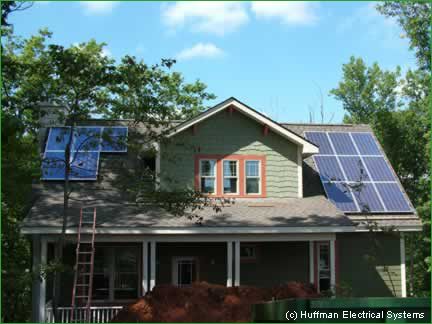Chris Williams
We can use simple, effective, and proven policies that have been used to supercharge the New England solar PV industry to incentivize renewable thermal technologies and eliminate oil use for single family homes. Here’s the best part, the policies will be cheaper than solar PV, they will create more local jobs per kW installed and displace more expensive fuel.
At Renewable Energy Vermont 2012, I delivered a presentation on how a production-based incentive for renewable thermal technologies, like the $29/MWh incentive in New Hampshire, would be cheaper than the current solar PV incentive in Vermont and could have a larger impact. The current incentive for solar PV in Vermont is $271/MWh for 25 years, but we could eliminate oil use for single family homes with a policy for renewable thermal technologies of $100/MWh guaranteed for five years. This policy would be much cheaper than the solar PV incentive and would drastically increase the adoption of biomass, air source heat pumps and ground source heat pumps. It would put a huge dent in oil consumption for single family homes, save money and create local jobs. If you’re new or curious about thermal incentives, Renewable Energy World has done some great reporting on it.
As I started to run the numbers when I was creating the presentation, I was blown away by how much energy renewable thermal technologies produced, and how valuable that energy is when displacing oil, propane and electricity. Many attendees at the talk had never seen the numbers broken out in a way that easily compares apples to apples. However, as any engineer knows, converting kWs to tons to BTUs is relatively simple. When we compare these technologies in the same terms, it starts to provide a very clear picture of the results that can be achieved by investing in proven renewable energy thermal technologies. These technologies include solar thermal systems, geothermal/ground source heat pumps, air source heat pumps, and biomass.
For the purpose of this article, I’m going to compare solar thermal and ground source heat pumps to a standard solar PV project in a baseline home. I’m using these technologies because I’m the most familiar with them. However, further analysis should absolutely include air source heat pumps and biomass technology.
Background: Why look at renewable thermal technologies?
We waste a lot of money on oil for space heating. Yes, oil industry, my goal is to put you out of business. But don’t worry, we’ll train you to install these new technologies. In addition to building and retrofitting buildings to have tighter shells, there are only three technologies, yes three, that can eliminate on-site fossil fuel use: biomass (pellets and cord wood), air source heat pumps, and ground source heat pumps. Here are a few pieces of data on why a focus on oil usage is so important for New England.
The EIA separates the US into five energy regions. ![]()
The Northeast uses the most oil for space heating, which also happens to be an extremely expensive fuel source. Six million homes use oil for heat, and the average home uses 800 gallons of oil per year, which equals roughly 4.8 billion gallons per year. ![]()
If we assume that the average residential price is $4 per gallon or slightly higher, home oil-heat spending is roughly $20 billion dollars per year.
![]()
These are huge industry trends, so let’s break the data down into something more tangible. U.S. census data reveals the number of single family homes in each specific state, this is the “total homes” column. I then broke down the heating fuel mix for each state, provided by the EIA, and found the number of single family homes in each state that use a high-cost fuel (oil, propane). You can see that the numbers are sizable. I then took the total number of homes and divided it by the number of homes using an expensive fuel source, which you can see on the far right. This means that nine out of 10 homes in Maine are using a very expensive fuel source. In Massachusetts, 54 percent, or five in 10 homes, use these sources. ![]() However, Massachusetts-specific data reveals that some communities use natural gas (that’s green). However, there are a large number of communities where 60+ percent of single family homes use an expensive fuel source.
However, Massachusetts-specific data reveals that some communities use natural gas (that’s green). However, there are a large number of communities where 60+ percent of single family homes use an expensive fuel source.
Solar PV is a great investment but doesn’t address oil use how can we address this problem?
The goal of this post is to show how we can use policies and incentives that have already been successfully implemented in the solar PV industry to address fossil fuel use for space heating in New England. I’ll provide a basic comparison of how solar pv and renewable thermal technologies compare when looking at fuel savings for property owners, direct job creation, and the cost of the incentive.
With that said, let me be clear: solar PV is a great investment. The purpose of this post is to be a “yes…AND”conversation. Solar PV will do nothing to address direct fossil fuel use. Additionally, the solar PV industry is large enough to be a great comparison tool because many people are familiar with the economics of solar PV. Thus, using solar pv as a baseline will make it easier to communicate the value of other technologies.
I’m also looking to address a question I recieve often: If geothermal heat pumps are so great, why aren’t more people using them?
How do we look at renewable energy policies?
When trying to understand renewable thermal technologies and the impact of different policies, a small number of variables seem to be critical for policy makers.
- Reduction in utility bills for property owners and reduction in fossil fuel use that is imported
- Local job creation
- Amount that said incentive costs for the state or utility
- Water quality and air quality issues
- 2,000 square feet
- 180 degrees
- 10 pitch roof (40 degrees) enough space for a 5-kW system.
- Requires 63MM BTU for heating (read average shell)
- Existing heating system is oil furnace with AC that must be replaced within two years. Replacing the existing oil furnace and AC unit with the same technology will cost $10,000.
- Electric rate is $.17kWh inflating at 3 percent per year
- Oil prices are at $4.00/gallon inflating at 5 percent per year
- $5.50 per watt times 5 kW = $27,500
- For those of you who think this is high. Think again. Read more on residential prices in Massachusetts at The Open PV project and the MA CEC’s website. Also, I have no reason to make solar PV seem high, I love the technology am a huge supporter of it.
- Produces 1,000 kWh per kW installed = 5,000 kWh or 5 MWh
- Value of energy is $850
- Local jobs created: 15 man hours per kW installed > 75 man hours (does not include sales, support and supply chain jobs, just direct construction jobs)
- Percent of year installed costs driven by rebates: 44 percent
- Gross installed costs to value of energy: $32
- Net installed cost to value of energy: $19
- 20 Year IRR, not considering equipment lifetime or O+M: 9 percent
2. Solar Thermal
- $110 per square foot gross installed costs
- 80 square foot system (2 modules @ 40 square feet per module)
- Gross installed costs = $8,800
- Net energy production per year: 4,100 kWh (140 therms)
- Value of energy production displacing #2 heating oil = $443 (140 therms is approximately 110 gallons of fuel oil)
- Local Jobs Created: 20 man hours per module (this is based on anecdotalle experience not an industry study, because they don’t exist) = 40 man hours.
- Incentives in Massachusetts: ITC, Personal Tax Credit, MA CEC Cash Rebate
- Percent of year one installed costs driven by rebates: 62 percent
- Gross Installed Costs to value of energy: $20
- Net installed costs to value of energy: $7.50
- 20 Year IRR: 12 percent
3. Geothermal
- Oil and AC replacement costs = $10,000
- Geothermal costs = $9,000 per ton X 4 tons = $36,000
- 4 ton = 14-kW system
- Geothermal premium = $26,000
- Oil heating costs = $3,000
- Geothermal heat costs = $1,000
- Geothermal Fuel Savings = $2,000
- Net geothermal energy production from the ground loop = 13,500 kWh
- Incentives: 30 percent ITC from $36,000 = $10,800
- 90 man hours per ton = 360 man hours for the job (25 percent of installed costs is labor: $36,000 X .25 = $9,000, and $1,000 is a week’s wage for 40 hours, so nine weeks work * 40 hours = 360 man hours / 4 tons)
- Percent of year 1 installed costs driven by rebates: 41 percent
- Gross installed costs / value of energy: $13
- Net installed costs / value of energy: $7.6
- 20 Year IRR: 14 percent
For those of you that love tables, I’ve put the data on a table as well.
Conclusions
There’s a lot of information in the above graph, so I made a few simple graphs that display and answer some specific questions.
Installed Cost per Watt
Geothermal costs roughly $2.57 per watt, while solar thermal costs $3.96 and solar PV is around $5.50. Yes, a lot of residential solar pv projects still cost $5.50 per watt. You may be able to reduce this to $4.00 per watt on new construction, but this trend is decreasing.
Energy Production per Installed kW
Solar PV generally produces 1 kWh per year for every 1 kW installed. A geothermal system will produce 13,500 kWh net energy from the ground loop, backing out the electric use for the pumps and compressor. A 4-ton system is 14 kW, so it produces slightly less then 1 kWh of net energy for every 1 kW installed. The solar thermal system is only a 2.22-kW system, but will produce 4,100 kWh of energy in one year.
Gross Invested Cost per Dollar of Energy Output
This metric is simple. Without considering any incentives (using just gross installed costs), how many dollars need to be invested to get $1 in fuel savings? Geothermal and solar thermal are clearly the winner here when displacing fuel oil. If they were displacing propane or electric they would be higher.
Gross Installed Cost to Net Installed Cost: How much do incentives drive returns?
This metric looks at how much incentives decrease installed costs by taking the gross installed costs and dividing them by all available incentives. What we see is that in Massachusetts, solar thermal is the most heavily subsidized technology, followed by solar pv and geothermal.
Net Invested Cost per Dollar of Energy Output:
After incentives are considered, we can look at the net energy investment required to get $1 in energy savings. Solar thermal and geothermal become more equal at $7.60 and solar PV is around $19. This means that to replace oil with a geothermal project in Massachusetts, you need to invest $7 to get $1 in fuel savings in year one.
Total Man Hours Needed per Job
This is looking at the total direct construction jobs to install a project. This is not based on any reports (because they don’t exist for solar thermal and geothermal), but anecdotal evidence. A typical 4-ton geothermal system will require 360 direct man hours in construction, and a solar thermal system will take 40 hours, and a solar PV project takes around 75 hours.
Direct Jobs Created per kW Installed
When we look at direct man hours per kW installed, geothermal and solar thermal create the most jobs, followed by solar PV. The reason for this has to do with the type of equipment being used. For geothermal and solar thermal technology, commodity equipment is used and repackaged in a different way. Components for these technologies aren’t industry specific, except for the actual solar thermal modules and geothermal heat pump, but these are easy to manufacture and thus there are many manufacturers. For the solar PV industry, all main components are specialized: modules, inverters and racking. Thus, equipment costs tend to make up a larger percentage of the installed costs. However, this is declining as economies of scale are reached on the manufacturing side of the business.
20-Year IRR with Current Incentives and Assumptions
This graph shows what the 20-year IRR of these different projects is with our given assumptions. Yes, the IRR of solar PV is getting much lower as installed costs drop and property owners see it as low risk, but also because Massachusetts SREC prices are declining. Geothermal is around 13 percent and solar thermal is around 12 percent.
20-Year IRR of All Technologies Received SRECs
This graph is answering a question I frequently hear: If geothermal is so amazing how come more people aren’t doing it? My answer is simple: If geothermal received the same REC prices as solar PV, no one would be using oil, geothermal would just be cheaper. So, if we assume that geothermal and solar thermal get paid $200/MWh for 10 years based on their output, their IRRs skyrocket to 30 percent.
Lessons earned and what implication does this have for policy in New England?
There are a few lessons we can learn from this analysis.
First, renewable thermal technologies can provide as good or better returns than solar PV technologies for property owners.
Second, renewable thermal technologies need more policy support, but they do not need as much support as solar PV. As you can see, a 30 percent IRR is too high. This is good for policy makers because it means that the cost of deploying renewable thermal technology will be CHEAPER than deploying solar PV. Renewable thermal technologies are cheaper and produce more valuable energy per kW installed, so more of the returns can come from displacing fuel than from a subsidy.
Third, renewable thermal technologies create more construction jobs per kW installed than solar PV.
Fourth, if we’re serious about incentives for renewable thermal technologies, we must use production-based incentives. Production-based incentives maintain quality control throughout the entire process: manufacturing, design and installation. A huge lesson learned in the solar PV industry is that incentives based on installed costs have huge flaws (installing solar PV projects in the shade is one example). Those modules on the left in the photo below will still receive a rebate even though they won’t produce must power.
Fifth, if any policy makers reading this happen to live in New England, my message to you is simple: If you’re bullish on the solar PV industry and believe that it’s a wise investment in terms of job creation, reducing emissions and saving property owners money, you should look into renewable thermal technologies as the next area of rapid growth. If you’re looking for the next technology that is going to create a huge number of jobs in your state and save a massive amount of money, you must look at renewable thermal technologies.
If you want to chat, I’d be happy to. Here’s my contact information: cwilliams@heatspring.com, 800-393-2044 ex. 33.
Chris Williams is the Chief Marketing Officer for HeatSpring Learning Institute a national renewable energy training company, Chairman of the Government Relations Committee for NEGPA and an advisor to Ground Energy Support, a provider of real time geothermal heat pump monitoring technology.
This article was first published on Renewable Energy World and is reprinted with permission.











This article strikes me as very important. Thank you for writing it! It will be very helpful to policymakers and activists who want to support jobs and fight CO2 emissions at the same time.